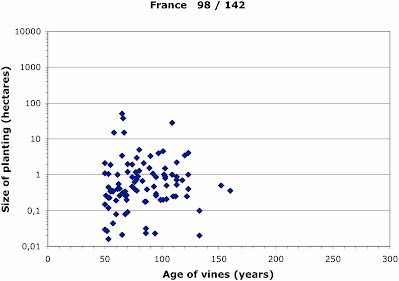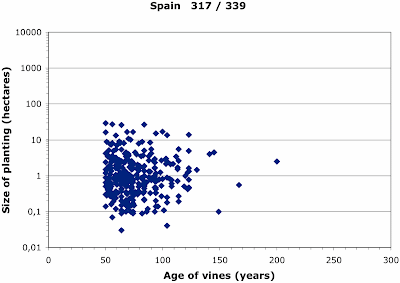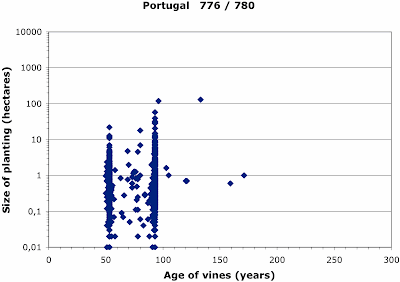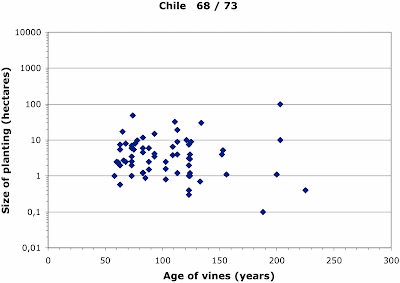Last week, I looked at Where in the world are the oldest vineyards and wineries? This week, I will look at the oldest vineyards in more detail, using the same dataset. As we will see, these vineyards vary from country to country, but not necessarily in the way that we might expect. Indeed, there are apparently only 14 UNESCO–listed vineyard sites around the world.
I will start by noting that some of the oldest vines are in Georgia and Slovenia, not unexpectedly, given their long history — indeed, wine is believed to have originally come from Georgia and the Caucasus region (and then spread from there to Greece and Italy). So, these days, Georgia has two of the oldest vine collections, at 400 and 250 years old, while Slovenia has a well-known single (massive) vine of 150 years of age. However, England claims to have the largest single grape-vine in the world (called The Great Vine), which is now 255 years old (as shown in this picture).
Below, I have produced a series of graphs, each one showing the ancient vineyards for a particular country. Each graph point represents one vineyard from the Old Vine Registry database. These vineyards are between 50 and 300 years old (horizontally), with their area shown vertically (note the logarithmic scale). Sadly, not every vineyard has its area listed in the database, so that they cannot all be shown in the relevant graph — the number of vineyards graphed out of the database total for that country is listed at the top of each graph.
France is the biggest wine producer in the world, and we might therefore expect the French to have preserved much of their vinous heritage. However, they have not really done so, at least compared to many of the other countries listed below.
Even more notably, given that Italy is the second biggest wine producer, it has done very poorly at preserving its vinous heritage. Indeed, this graph is somewhat embarrassing — the locals apparently do not value the concept of old vines. It is perhaps worth noting, though, that there is one vineyard with plants that are 350 years old (and thus not in the graph).
In many ways, Spain is the big gun in the world of old vineyards. The next graph shows you that there are oodles of them, especially compared to France and Italy. In this sense, Spain has been a very conservative country viticulturally, and thus preserved its vinous heritage well.
Notably, the USA also has many older vineyards, almost as many as Spain (although area data are missing for half of them). This situation may surprise a lot of people, since the USA has a reputation for constant renewal (ie. the infamous “disposable society”). However, the vinous heritage has clearly been of importance to many Americans, for which we can all be pleased.
Like the USA, Australia also has managed to keep quite a few of its oldest vineyards. Indeed, relatively speaking, it has actually done somewhat better, in terms of numbers. Who has been copying whom?
Portugal has the oddest graph of the lot, as shown next. Last week, I pointed out three peaks in vineyard numbers based on age, at 1930, 1960 and 1970, attributing them as simply being approximate years (rather than accurate records). However, a commentator on that post noted: “there is something very interesting going on in Portugal in 1930 and 1970 that led to hundreds of vineyards being planted in those years in the Douro region ... it's super odd to see so many producers with a 1930 planting and a 1970 planting, over and over and over again. I'm thinking government subsidies, or something like that”. This odd pattern is clearly evident as the two vertical rows of points in the next graph. An explanation would be very interesting to read, if anyone knows one.
Chile has an old vinous heritage, and it has managed to keep quite a few of its oldest vineyards. Indeed, it has more of the world’s oldest ones than any other country — at least half a dozen are >150 years old, including one quite large vineyard.
Argentina has many fewer old vineyards, compared to Chile, and so has done less than it probably could have.
Compared to many other countries, South Africa has also not done very well at preserving its older vineyards. Indeed, it is the worst of the world’s large wine-producing countries.
Given its long heritage, Germany has also not done well at preserving much of its heritage. Indeed, it makes even Italy look good. It has been good at keeping its old castles, for the tourists to look at, but the vineyards near them along the scenic rivers are much more recent. It is perhaps worth noting, though, that there is one vineyard with plants that are nearly 400 years old and another at 600 years old (not graphed).
Finally, we come to Turkey, one of the oldest wine-making places on the planet. Therefore, it is good to see that it still has some of the oldest vineyards, as well as one very large old vineyard (at the top of the graph). However, the latter is noted in the database as being communal: “an area of 1,980 hectares, with 120 households and 774 people.” Sadly, this is not to say that there are no problems with the current old-vine situation in the country; see: Turkey's old vines: a disappearing delight.
So, the older vineyards are not randomly distributed among the wine-making regions of the world. Some places have definitely done better than others at preserving their vinous heritage.













No comments:
Post a Comment